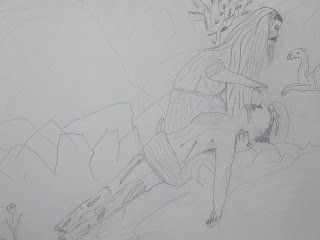
Today I taught about the Good Samaritan. While I was researching for the lesson, I came across an article written about the deeper symbolism in the story, and wanted to share it. My cute daughter drew a picture of the scene to help with my lesson...
The Good Samaritan:
Forgotten Symbols
Notes from lecture by John W. Welch at Danville Stake Center, Danville, California, March 5, 1999. Brother Welch is the founder of F.A.R.M.S, and the discover of chiasmus in the Book of Mormon.
The Good Samaritan (Luke 10: 25-37)
Brother Welch began by asking "Where in the New Testament does Christ ever teach the plan of salvation?" Good question. He then answered that question. He showed a picture of Chartes, the cathedral in France, and of a stained glass window found there. He explained that stained glass windows were to be "read" as stories, teachings. This particular window had the story of the Good Samaritan, told in a series of ascending panels. Then just above this was the story of the fall of Adam, and the crucifixion of Christ.
This fascinated him. Then he found two other stained glass windows in cathedrals in France that did the same thing. Only on these two, the story of the Good Samaritan was told in a series of descending pictures, each in a circle. To the side of each of the pictures and surrounding each were a series of four pictures, each having to do with the fall of Adam, the law of Moses, the crucifixion and resurrection of the Savior. He wondered why these would be portrayed side by side in this way. Then he began to study the writings of the early Church Fathers and discovered that they believed the parable of the Good Samaritan was given to teach about the fall of Adam and the redemption by Christ. He wondered just how this could be. Then he read in one of the earliest Church Fathers, Origen, that he had it from the "elders," those who personally knew Christ, that in this parable the man "who went down" was Adam - and by extension, we know as members of the Church, all mankind. The man left Jerusalem, which signified Heaven - the Holy City. Jericho was the world. The robbers were Satan and other evil persons and influences. The Priest and Levite represented the Law and the Prophets, and the Samaritan - Christ. The beast on which the injured man was carried was said to be the body of Christ. The Inn to which he was taken was the Church and the innkeeper the head of the Church. The two coins he gave were dinari (sp?).
The interpretation was this - a certain man (Adam) (and all mankind) "went down" from Heaven (Jerusalem) to earth (Jericho) and "fell" because of the temptations which beset him. The robbers (Satan, the temptations of the world) stripped him of his garments and left him half-dead. Brother Welch said they stripped him of the garment of immortality, leaving him in a "half-dead" (meaning spiritual death but not yet mortal death) state. The Priest and Levite come by but do not help. He pointed out that in the pictures, and in some early writings, the Priest and Levite are not so much deliberately ignoring him as unknowing and helpless- they do not know what to do, and seem incapable or really doing anything. They hold the Aaronic priesthood, which is not able to save him.
Then the Samaritan comes. This represents Jesus. Why Jesus a Samaritan? The Samaritans were hated and despised. Jesus was hated and despised and rejected. In John 8:48, the Jews said they called Jesus a Samaritan. The Samaritan comes from "another world" as far as the Jews are concerned. The Samaritan binds up the man's (Adam - mankind) wounds and pours on oil (anoints) and washes with wine (blood). He puts the wounded man on a beast (body of Christ according to early Church Fathers- remember the membership of the Church is sometimes referred to as the body of Christ). He is borne to the Inn (Church) and welcomed by the innkeeper (Church leader).
The Samaritan says he must go away for a while and gives 2 dinari (sp?) (2 days wages) to the innkeeper. This is enough to care for the man for two days. He apparently will return on the third day. 2 dinari (sp?) also equals ½ shekel, the amount of the temple tax, which means the debt owed to the temple for the man is now paid. His debts have been squared.
He tells the innkeeper "I will come again." Christ will come again. And whatever else is owed to redeem the man, He will pay. Remember that this dialogue started with the lawyer asking the Savior, "What shall I do to inherit eternal life?" So, while the Savior answers the following question about who is neighbor to the man, he is also answering the first question asked, and explaining that eternal life is given by Him who has the authority and the love of mankind to care for those that have fallen and to make them whole. Those in the Church are to help in this undertaking. And as he ends, he says "Go and do likewise" (Go and become Christ-like.)
the Good Samarian--Jesus Christ
Viction--Man wounded with sin
Jerusalem--Paradise
Jericho--World
Priest--Law of Moses
Levite--Prophets
Beast--Christ's body
Inn--Church
Manager of the Inn--Head of the Church
I am so grateful for the many times in my life, when I have been weak and weary, physically or spirtually beaten, that my Savior has been there to assist me, to bind up my wounds, and to carry me to safety and shelter...I hope we can all be someone's Good Samaritan, just as Christ is to us...

1 comment:
Nice thoughts. I hadn't thought of it that way.
Thanks!
Post a Comment